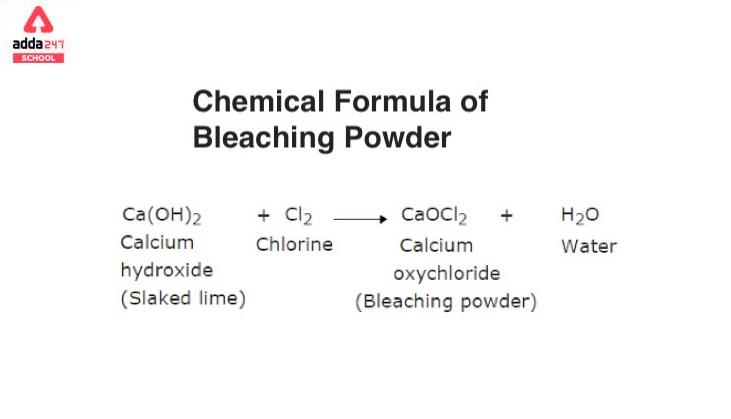Bleaching Powder Formula
Bleaching powder is an inorganic compound, chemically known as Calcium Hypochlorite. Calcium Hypochlorite is the main component of Bleaching powder. The atoms included in bleaching powder are calcium, oxygen, and chlorine. There are two atoms of chlorine, one atom of chlorine makes a strong bond with calcium atoms, and the other atom forms a bond with oxygen atoms.
Bleaching Powder caocl2 Chemical Name
The chemical name for CaCl2 is calcium chloride. and the chemical formula of Bleaching Powder is CaoCl2
caocl2 Common Name
Caocl2 Common name is bleaching Power.
Chemical Formula of Bleaching Powder
Chlorine gas is reacted with dry slaked lime, which gives the Bleaching Powder chemical formula, Ca(ClO)2.
Ca(OH)2 + Cl2 —————— CaoCl2 +H2O
Characteristics of Bleaching Powder
- Color- Pale yellowish
- Odour- Strong smell
- Solubility- Bleaching powder is soluble in water and is dissolved easily.
Bleaching Powder ka Sutra
bleaching powder ka sutra Caocl2 hota hai. ब्लीचिंग पाउडर एक अकार्बनिक यौगिक है, जिसे रासायनिक रूप से कैल्शियम हाइपोक्लोराइट के रूप में जाना जाता है। कैल्शियम हाइपोक्लोराइट ब्लीचिंग पाउडर का मुख्य घटक है। ब्लीचिंग पाउडर में शामिल परमाणु कैल्शियम, ऑक्सीजन और क्लोरीन हैं। क्लोरीन के दो परमाणु होते हैं, क्लोरीन का एक परमाणु कैल्शियम परमाणुओं के साथ एक मजबूत बंधन बनाता है, और दूसरा परमाणु ऑक्सीजन परमाणुओं के साथ एक बंधन बनाता है।
Bleaching Powder ka Formula
सूखे बुझे हुए चूने के साथ क्लोरीन गैस की अभिक्रिया करके ब्लीचिंग पाउडर का रासायनिक सूत्र Ca(ClO)2 प्राप्त होता है।
Ca(OH)2 + Cl2 ——————- CaoCl2 +H2O
ब्लीचिंग पाउडर के लक्षण
रंग- हल्का पीला
गंध- तेज गंध
घुलनशीलता- ब्लीचिंग पाउडर पानी में घुलनशील होता है और आसानी से घुल जाता है।
ब्लीचिंग पाउडर रासायनिक नाम और सूत्र
ब्लीचिंग पाउडर का रासायनिक सूत्र (कैल्शियम हाइपोक्लोराइट)
सीए (सीएलओ) 2
ब्लीचिंग पाउडर का मोलर मास कितना होता है?
मोलर द्रव्यमान एक यौगिक में मौजूद अणुओं का द्रव्यमान है। ब्लीचिंग पाउडर या कैल्शियम हाइपोक्लोराइट में कैल्शियम, ऑक्सीजन और क्लोरीन जैसे अणु होते हैं।
ब्लीचिंग पाउडर का मोलर द्रव्यमान ब्लीचिंग पाउडर में मौजूद प्रत्येक यौगिक के द्रव्यमान का योग होगा।
ऑक्सीजन का द्रव्यमान + नाइट्रोजन का द्रव्यमान + कैल्शियम का द्रव्यमान = कैल्शियम हाइपोक्लोराइट का मोलर द्रव्यमान, जो कि 142.98 ग्राम/मोल है।
ब्लीचिंग पाउडर का उपयोग।
इतने सारे गुणों के साथ ब्लीचिंग पाउडर के कई उपयोग हैं। उनमें से कुछ नीचे सूचीबद्ध हैं।
एक कीटाणुनाशक के रूप में उपयोग किया जाता है, ब्लीचिंग पाउडर का उपयोग पानी को शुद्ध करने के लिए किया जाता है। पानी में ब्लीच मिलाने से यह साफ हो जाता है और हानिकारक बैक्टीरिया नष्ट हो जाते हैं।
इसकी ऑक्सीकरण संपत्ति के कारण, कई रासायनिक उद्योगों में उपयोग किया जाता है।
कपड़ों को ब्लीच करने के लिए इस्तेमाल किया जाता है, इसलिए उन्हें कपड़े धोने में उपयोगी बना दिया जाता है।
सभी उपयोग एक दूसरे से भिन्न हैं और यदि आप देखें, तो ये सभी एक दूसरे से संबंधित नहीं हैं। ब्लीचिंग पाउडर हर जगह अलग तरह से काम करता है।
Bleaching powder- Molar Mass
Molar mass is the mass of the molecules present in a compound. Bleaching powder or Calcium Hypochlorite has molecules like Calcium, oxygen, and chlorine.
The molar mass of bleaching powder will be the sum of the mass of each compound present in bleaching powder.
Mass of oxygen + mass of Nitrogen + mass of calcium = Molar mass of calcium hypochlorite, which is 142.98 gram/mol.
Bleaching powder- Uses
With so many properties, there are many uses of bleaching powder. Some of them are listed below.
- Used as a disinfectant, the bleaching powder is used to purify water. Adding bleach to water makes it cleaner and destroys harmful bacteria.
- Used in many chemical industries, because of its oxidizing property.
- Used to bleach clothes, hence making them useful in the laundry.
All the uses are different from each other and if you see, all of them are not related to each other. Bleaching powder works differently everywhere.
What are the different problems we face if bleaching powder is not handled with proper care?
All the chemicals have their advantages and disadvantages. If handled with care it gives desired results but if handled carelessly it will cause many problems and infections.
The harms of Bleaching powder are-
- Bleaching powder has a strong smell because of the presence of chlorine. When heated, the fumes produced are very dangerous if inhaled. It will cause severe damage to your respiratory system.
- If coming in contact with your skin, it can irritate because it is corrosive.
- If it comes in contact with the eyes, it can damage it severely and can form lumps.
- It is a very harmful chemical, if you swallow it by mistake, it will damage your body internally and externally.
Bleaching powder-The thing you need to know
- What happens when bleaching powder reacts with sulphuric acid?
The chlorine present in the bleaching powder will be released giving us the equation
Ca(Cl)2 + H2SO4
- What happens when bleaching powder is left untouched for a long period?
The bleaching powder will react to moisture and air, forming two other components called Calcium Chloride and Calcium chlorate. It also makes the effectiveness of the bleaching powder weak.
Bleaching powder- A quick recap
- The bleaching powder formula is CaOCl2
- The chemical name is calcium hypochlorite
- The molar mass of the Bleaching powder is 142.89 grams/mol
- Used in industries, used as a disinfectant, used in laundry.
- Bleaching powder can cause severe damage to the human body if not handled properly
Related Articles:









 CUET UG Final Answer Key 2025 Revised, D...
CUET UG Final Answer Key 2025 Revised, D...
 DU Cut off 2025, Delhi University Expect...
DU Cut off 2025, Delhi University Expect...
 OUAT Result 2025 OUT @ouat.nic.in: Check...
OUAT Result 2025 OUT @ouat.nic.in: Check...









